Pittsburgh Pirates 2018 season review

The Pittsburgh Pirates had a streaky 2018 season that exceeded expectations with 82 wins but still left them eight games out of a playoff spot.
The 2018 Pittsburgh Pirates were over .500 for the first time since their last postseason appearance in 2015. Still, it wasn’t enough to be competitive in a division that included the Milwaukee Brewers, Chicago Cubs and St. Louis Cardinals. The Brewers led the NL in wins. The Cubs were second. The Cardinals were sixth.
The Pirates were tied for seventh in wins in the NL and finished fourth in their division behind the Brewers, Cubs and Cards, but well ahead of the last-place Cincinnati Reds. Despite their fourth-place finish, they exceeded expectations with a record of 82-79. Their average projection was for around 75 wins, which was similar to the previous two seasons. In 2017, the Pirates were 75-87. In 2016, they were 78-83.
The season started well. The Pirates won 11 of their first 14 games and were in first place in mid-April. Then they began a back-and-forth of winning streak and losing streaks for the next six weeks. They lost five straight from April 19 to April 25, then won five straight, then lost four straight. They had another five-game winning streak in early May, then two four-game losing streaks later in the Month.
This back-and-forth streakiness was also reflected in their monthly records. They were 17-12 in March/April, then 12-15 in May and 10-16 in June. Just when you thought the season was a lost cause, they went 17-9 in July, which included an 11-game winning streak that started before and ended after the All-Star break.
At the July 31 trade deadline, the Pirates were 56-52. They were six games back in the NL Central and three games out of a wild card spot. To the surprise of many, they actually made a mid-season trade to bolster the team. In fact, they made two trades. More on those trades later.
Once again, just when Pirates fans had some hope again for 2018, the team flopped, going 10-17 in August, which included one stretch in which they lost nine of eleven. Of course, they recovered to go 16-10 in September because that’s just how this team was. In March/April, July and September, the Pirates were 50-31 (.617). In May, June and August, they were 32-48 (.400).
It’s hard to know what to make of this team. At times, they looked like contenders. At other times, they looked a few years away from contention. For the most part, fans didn’t buy in. The Pirates’ attendance dropped by 454,000 fans, which was the sixth-biggest drop in baseball. The five teams with bigger drops in attendance averaged 101 losses.
We’ll look at what went right and what went wrong, but first let’s look at some of the big moves they made before the season began.
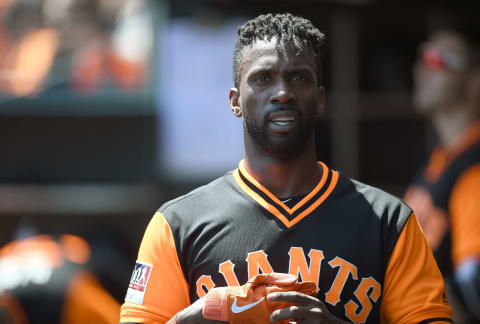
2018 Pirates: Preseason Moves
Just after the calendar flipped to 2018, Pirates fans learned they would have a significantly different team this year. They would be without longtime fan favorite Andrew McCutchen and staff ace, Gerrit Cole. On January 13, Gerrit Cole was traded to the Houston Astros for Michael Feliz, Colin Moran, Joe Musgrove and minor leaguer Jason Martin.
Cole was traded with two years left before he can become a free agent after the 2019 season. The Pirates weren’t going to spend the money to keep him, so they dealt him to the Astros, where he had the best season of his career. According to Fangraphs, he was worth 6.3 Wins Above Replacement (WAR) in 2018.
The players the Pirates received for Cole were an interesting mix. Moran played in 144 games but only started 110. He was often on the bench against left-handed pitching. In 465 plate appearances, he hit .277/.340/.407 and was worth 0.7 WAR. Most important to the penny-pinching Pirates is that he won’t be a free agent until 2024.
Joe Musgrove started 19 games and had a 4.06 ERA and 1.18 WHIP in 115.3 innings. His FIP was 3.59, which suggests he pitched a bit better than his numbers. His season was limited by injuries, including an abdominal strain at the end of the year. He was worth 2.1 WAR.
The third major leaguer acquired in the Cole trade was relief pitcher Michael Feliz and his season was a disappointment. He had a 5.66 ERA and 1.51 WHIP in 47.7 innings (4.13 FIP). Walking 23 batters was a big part of his problem. He was worth 0.1 WAR.
The major league tally came out to 6.3 WAR for Cole and a combined 2.9 WAR from Moran, Musgrove and Feliz. The minor leaguer acquired in the trade, Jason Martin, hit well in Double-A (.325/.392/.522), but struggled in Triple-A (.211/.270/.319). As a prospect, he’s considered more of a bench player than a starter.
Two days after dealing Cole, the Pirates traded longtime franchise icon Andrew McCutchen to the San Francisco Giants for reliever Kyle Crick and minor league outfielder Bryan Reynolds. Cutch had one year left on his contract before free agency and the Pirates wanted to get something for him.
McCutchen ended up splitting his season between the Giants and the Yankees, hitting .255/.368/.424 and being worth 2.6 WAR. He wasn’t the McCutchen of old, the one who averaged 6.9 WAR per season from 2011-2015, but that WAR total would have made him the third-best position player on the 2018 Pirates.
For his part, Krick was an effective reliever, with a 2.39 ERA and 3.14 FIP in 60.3 innings. He was worth 1.0 WAR. Reynolds was injured early in the season while playing at Double-A. When he returned, he hit .302/.381/.438 in 88 games. According to Fangraphs, he “doesn’t produce the power you look for in a corner outfielder and he doesn’t play center field well enough to be out there every day.”
It’s always tough when top players are traded away. Rumors about McCutchen and Cole being traded had been flying around for a couple years and fans likely hoped they would get more in return. With the McCutchen deal, the Pirates saved quite a bit of money so the return was less. With Cole, they received multiple players who will hopefully help the team for a few years.
In February, the Pirates made a trade with the Tampa Bay Rays. They acquired outfielder Corey Dickerson for reliever Daniel Hudson and minor leaguer Tristan Gray. Dickerson had a solid season, hitting .300/.330/.474 and being worth 2.7 WAR. Hudson was released by the Rays in late March and picked up by the Dodgers in April. He finished the year slightly below replacement-level.
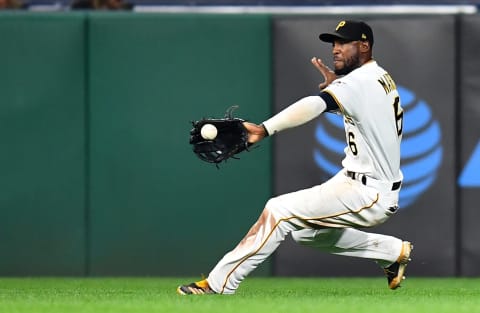
2018 Pirates: What went right
One year removed from an 80-game PED suspension, outfielder Starling Marte was back being the player he was before. He had a career-high 20 homers. He stole 33 bases. He was good in the field. He had 3.7 WAR, which is close to what he did in 2016 (3.8 WAR). He’ll make $10.3 million in 2019 and the Pirates have team options for $11.5 million and $12.5 million in 2020 and 2021. If the Pirates continue the pattern they’ve established recently, this time next year Marte will likely be the prominent Pirates player with trade rumors swirling around him.
Despite being hampered by concussions, catcher Francisco Cervelli had one of his best seasons. He’s always been good at getting on base, but added some home run pop to his game this year, as he launched a career-high 12 dingers. He was also good behind the dish and finished with 3.3 WAR.
Corey Dickerson, the pre-season trade acquisition mentioned earlier, had a solid but inconsistent season. The metric wRC+ measures a player’s contributions on offense after league and ballpark effects are accounted for. A 100 wRC+ is league average. For the season, Dickerson had a 115 wRC+, meaning he was 15 percent better than league average.
The inconsistency shows up in his wRC+ each month:
March/April—128 wRC+
May—116 wRC+
June—67 wRC+
July—234 wRC+
August—24 wRC+
September/October—145 wRC+
That amounts to four good months and two dreadful months. Dickerson is arbitration eligible and should be cheap enough to be with the Pirates until he hits free agency in 2020.
A couple other position players who had above-average seasons were outfielder Gregory Polanco and catcher Elias Diaz. Polanco led the team in home runs and RBI and was worth 2.5 WAR. Diaz was worth 2.0 WAR in just 82 games. According to Fangraphs, the Pirates’ combination of Cervelli and Diaz led all of baseball in WAR by catchers. Another bright spot was Adam Frazier, who hit .277/.342/.456 in 113 games (1.9 WAR).
The top dog on the mound was Jameson Taillon. With a 3.20 ERA in 191 innings (3.7 WAR), he took over the role of staff ace from Gerrit Cole. He wasn’t as good as Cole was this year, but his season was better than four of the five seasons Cole pitched with the Pirates. Taillon should lead the rotation for the next few years.
While Taillon had the best season of any Pirates pitcher, the most surprisingly good season was produced by Trevor Williams. He finished with a 3.11 ERA in 170.7 innings. He was particularly good in the second half. In 13 starts from July 11 to the end of the season, Williams had a 1.29 ERA in 76.7 innings. Not to put a big damper on his season, but it should be noted that Williams had a FIP of 3.86. That’s still good, just not 3.11 good.
Joe Musgrove only started 19 games, but was still right around league average (2.1 WAR). He was particularly adept at throwing strikes. Among the 128 starting pitchers with at least 110 innings pitched, Musgrove had the 12th-lowest walk rate (4.7 percent).
In the bullpen, Felipe Vazquez had another good season, with 37 saves and a 2.70 ERA in 70 innings (2.1 WAR). It wouldn’t be surprising if many Pittsburgh fans thought Vazquez had a bad year because of the brutal run of games he had in May. In six appearances from May 20 to the end of the month, Vazquez had four of the five blown saves he would have all year. He righted the ship after that and posted a 1.70 ERA over his last 46 games.
Another reliever who had a good season was Richard Rodriguez. R-Squared finished with a 2.47 ERA and 2.60 FIP in 69.3 innings. He was one of three Pirates relievers to strike out at least 30 percent of the batters they faced. The others were Vazquez and Keone Kela.
The above was some of the good that happened with the Pirates in 2018. Before we get to the bad, let’s consider the two deadline deals the team made, including the surprising move to add Chris Archer.
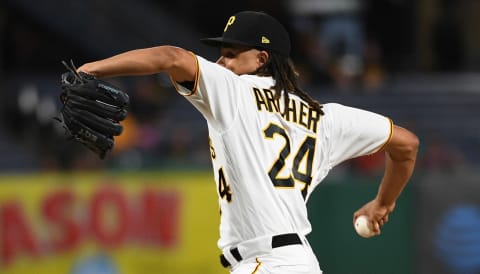
2018 Pirates: Acquiring Archer
After losing their fifth straight game on July 7, the Pirates were 40-48 and 12.5 games out of first place in the NL Central. It looked like they were on their way to another ho-hum 75-win season. Then they won 13 of their next 14 games and 16 of 20. By the July 31 trade deadline, they were 56-52, six games back in the division and three back in the wild card race.
That hot streak prompted the Pirates to do something they hadn’t done during their three-year run of playoff season from 2013-2015. They made a significant in-season trade to bolster the team for the stretch run. In fact, they made two trades. The side dish was a deal with the Rangers for reliever Keone Kela, who proved to be a good addition to the bullpen (2.93 ERA in 15.3 innings).
The main dish was Chris Archer. To get Archer, the Pirates surrendered pitcher Tyler Glasnow and outfielder Austin Meadows. They later added minor leaguer Shane Baz as the player to be named later. It was a significant price to pay.
Glasnow was on multiple top prospect lists each year from 2014 to 2017, reaching as high as ninth on the MLB Pipeline Top 100 prior to the 2017 season. Meadows had also appeared on multiple top-100 lists, including a top ranking of sixth on the Baseball America top-100 prior to the 2017 season. Baz was 67th on the MLB Pipeline list prior to this season. These were good, young prospects that fans in Pittsburgh had been hearing about for a while. To see them traded away was surprising, to say the least.
Archer is a talented pitcher, no question, but his best seasons were from 2013 to 2015. He had a 3.26 ERA in 89 starts during those three seasons and his 3.36 FIP suggests it wasn’t a fluke. He had a good strikeout rate, didn’t walk too many batters and did a good job of suppressing home runs.
He still has strong strikeout and walk rates, but he’s allowed too many home runs over the last three years and his ERA has gone up as a result. Since the start of the 2016 season, Archer has a 4.12 ERA in 550.7 innings, although his FIP is just 3.64. After the trade this season, Archer had a 4.30 ERA in 52.3 innings with the Pirates. Fangraphs credited him with 0.7 WAR.
Meanwhile, in Tampa Bay, Glasnow had a 4.20 ERA (4.38 FIP) in 55.7 innings and was worth 0.5 WAR. Meadows didn’t get much playing time with the Rays. Both project to be regulars in the major leagues and both will be under team control for many years to come. You can’t help but wonder if the Pirates would like a do-over on this deal.
If you feel Archer can get back to the pitcher he was from 2013-2015 then the Archer trade can be put in the “what went right” column. If you think it was a mistake to trade two good, young players for an aging pitcher who has been disappointing in the last three years, you could put the deal in the “what went wrong” column.
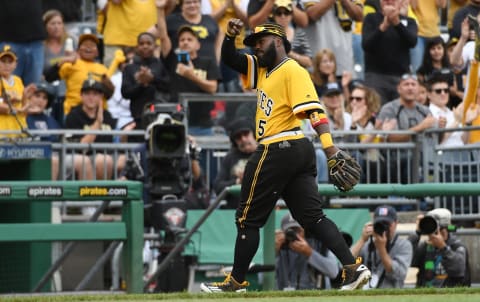
2018 Pirates: What Went Wrong
One of the feel good stories for the Pirates during their recent run of postseason appearances was the breakout season by Josh Harrison in 2014. That year, Harrison suddenly hit .315/.347/.490, with 13 homers and 18 steals while playing a dozen or more games at four different positions. He was an all-star and even received enough votes to finish ninth in NL MVP voting.
Unfortunately, Harrison hasn’t come close to repeating that season and he was particularly bad in 2018. Getting on base was a big problem, as he finished the year with a .293 OBP. Also, he only played in 97 games because of a hand injury suffered in mid-April. It was the same injury that ended his 2017 season. The Pirates have a $10.5 million team option on Harrison, but it is highly unlikely they will exercise it. Instead, they’ll pay the $1 million buyout and let him walk.
Another Josh who struggled for the 2018 Pirates was Josh Bell, which is nothing new. Bell had a superficially good season last year, when he hit 26 homers and had 90 RBI. His 108 wRC+ made him just eight percent better than average on offense. When you add in his subpar base running and poor defense, he was just a 0.6 WAR player in 2017.
In 2018, Bell’s home runs dropped from 26 to 12 and his slugging percentage plummeted from .466 to .411. He had a better on-base percentage, though, which combined with a tougher hitting environment to give him a 112 wRC+. That’s better than last year, despite the lack of home runs. Add in his still-poor base running and bad defense and he was worth just 0.9 WAR. Bell is a fine placeholder as long as his salary is low, but he hasn’t shown that he can help push a team to a postseason spot.
Other disappointing position players were Jordy Mercer and Sean Rodriguez. Mercer now has four straight seasons with between 0 and 2 WAR. He’s been better than replacement-level but below league average. Rodriguez couldn’t recapture the magic of his terrific 2016 season. Injuries limited him to 66 games and contributed to his .167/.277/.313 batting line. Both Mercer and Rodriguez are free agents.
The worst member of the Pirates’ rotation was Nick Kingham, with a 5.21 ERA and 5.65 FIP in 76 innings. His main problem was the long ball. Among the 212 pitchers with 70 or more innings pitched in 2018, Kingham allowed the fourth-highest rate of home runs per nine innings (2.1 HR/9).
Chad Kuhl also struggled. He started 16 games and allowed 14 home runs in 85 innings, with a 4.55 ERA and 4.70 FIP. He went on the DL in June and had Tommy John surgery in September. He’ll miss the entire 2019 season.
Out of the bullpen, reliever Dovydas Neverauskas was knocked around for an 8.00 ERA and 6.72 FIP in 27 innings. He allowed at least one run in 15 of his 25 appearances and two or more runs in seven appearances.
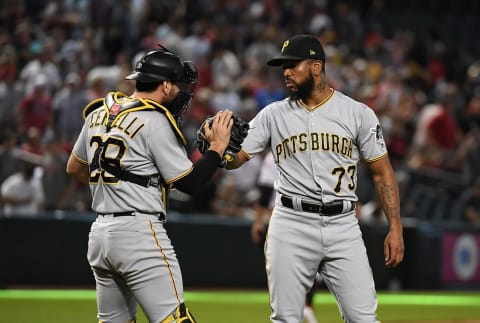
2018 Pirates: Outlook for 2019
The Pirates have the second-lowest estimated payroll in the National League, ahead of only the San Diego Padres, but don’t expect them to open up their pocketbooks and sign Manny Machado or Bryce Harper in free agency. They don’t shop in that neighborhood. Their highest-salaried holdovers will be Francisco Cervelli ($11.5 million), Starling Marte ($10.3 million) and Ivan Nova ($9.2 million). As things are now, the lineup, rotation and bullpen look like this:
More from Call to the Pen
- Philadelphia Phillies, ready for a stretch run, bomb St. Louis Cardinals
- Philadelphia Phillies: The 4 players on the franchise’s Mount Rushmore
- Boston Red Sox fans should be upset over Mookie Betts’ comment
- Analyzing the Boston Red Sox trade for Dave Henderson and Spike Owen
- 2023 MLB postseason likely to have a strange look without Yankees, Red Sox, Cardinals
C—Francisco Cervelli/Elias Diaz
1B—Josh Bell
2B—Adam Frazier
SS—Kevin Newman
3B—Colin Moran
LF—Corey Dickerson
CF—Starling Marte
SP—Chris Archer
SP—Ivan Nova
SP—Joe Musgrove
RP—Keone Kela
RP—Kyle Crick
RP—Michael Feliz
The biggest change for the Pirates will be in the middle infield. This actually started last season when Adam Frazier started 47 games at second base and Kevin Newman started 19 games at shortstop. Frazier was much better than Newman (.209/.247/.231), but it should be remembered that this was Newman’s first taste of big league action. There’s also the possibility of the Pirates re-signing Mercer for a backup role.
A wild card in the mix for next year is Jung Ho Kang. It’s been reported that the Pirates are open to bringing Kang back as a third baseman but would prefer to find some middle ground between the $5.5 million team option and the $250,000 buyout. Kang missed the entire 2017 season with legal issues that prevented him from playing in the U.S. He was cleared to play this year, but only had six major league plate appearances at the very end of the season.
The Pirates minor league system was ranked 17th among the 30 MLB teams by Bleacher Report in September. Their top prospect is pitcher Mitch Keller, who was ranked 12th on the Baseball America Top-100 prior to the season. He had a 3.48 ERA in 142.3 innings while pitching mainly in Double-A and Triple-A. He’s an elite pitching prospect who could get to the big leagues at some point next season.
Third baseman Ke’Bryan Hayes hit .293/.374/.444 in Double-A as a 21-year-old. He doesn’t hit for the power you’d like to see from a third baseman, but could be a 40-doubles guy with a good glove. He’s not likely to be a regular until 2020 or later.
Another player more likely to establish himself in 2020 than 2019 is shortstop Cole Tucker, who hit .259/.333/.356 as a 21-year-old in Double-A. While he doesn’t have much pop, he can steal a base. He had 35 steals in 2018 after stealing 47 bases in 2017.
There’s still a whole offseason to go, but at this point it looks like the 2019 Pirates will be much like the 2018 Pirates. The’ll have a full season of Chris Archer, with the hopes that he can be better than he’s been the last few years. With a steady if not spectacular lineup and a (hopefully) good Chris Archer joining Jameson Taillon at the top of the rotation, they should finish over .500. The next step is for the minor leaguer system to provide upgrades in the next few years.